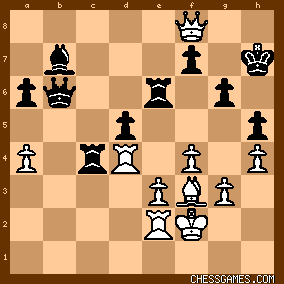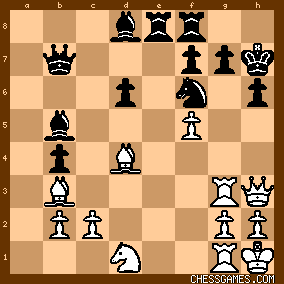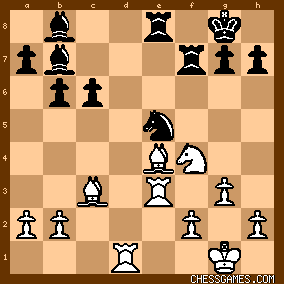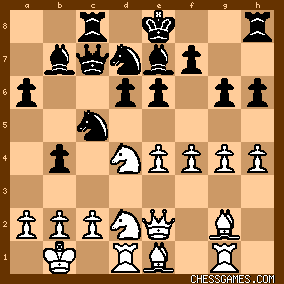|
Introduction: An eight-game playoff match for the Nordic Championship between Bent Larsen and Fridrik Olafsson held in Reykjavik, Iceland from 17th January to 1st February 1956. The match was hosted by the "Sjómannaskólanum" (Seaman's School) in the Háteigsveig suburb of Reykjavík (1) The players
They had played four times previously, their first crossing of swords being at Junior World Championships in Birmingham, England, in 1951. Olafsson had won three of these games but had lost their last encounter in the Nordic Championship in Oslo in August 1955. Both players were 20 years old at the start of the match. Olafsson celebrated his 21st birthday on the 26th January. Although still a law student, by 1956 he had already been Icelandic champion twice (in 1952 and in 1953) and in 1953 he had come third in the World Junior Championship in Copenhagen where he had beaten Larsen (Larsen vs F Olafsson, 1953). Olafsson's first international tournament was Hastings (1953/54) where he came fourth equal. In 1954, Olafsson played in the Marianske Lazne - Prague Zonal Tournament coming sixth in a strong field and then in September he had played for Iceland in the Amsterdam Olympiad. During late November and early December 1955, he defeated the world championship candidate Herman Pilnik 5-1 in a match in Reykjavik. Olafsson then returned to Hastings Hastings (1955/56) this time to tie for first. These results augured well for the playoff for his tie with Larsen in the 1955 Nordic Championship. According to Larsen, "The year 1955 started with a partial failure; I only managed to share first place in the Copenhagen Championship (with Axel Nielsen e.d. )…After that, I took part in the Danish Championship and scored 10 out of a possible 11. In August I played in the Scandinavian Championship (Nordic – e.d.), which took place in Oslo, and although I didn't play very well in all the games, I shared first place with Fridrik Olafsson who I beat in the last round … I flew (in January 1956 – e.d.) to Reykjavik where the tier for the Scandinavian Championship has to be decided by an eight-game match. In those days Olafsson was a national hero. He had beaten Herman Pilnik in a match and at Hastings (1955/56) shared first with Viktor Korchnoi. The enthusiasm on the island was fantastic; everyone followed our match with great interest. But what was wrong with Olafsson? I took the lead 3½-1½. But in the sixth game, I blundered in a position that was clearly drawn and I played very badly in the seventh. The situation was now 3½ points all with one game left and both of us were very nervous…" (2) Larsen arrived in Reykjavík on Sunday night (15th January) two days before the start of the match. Both players declared themselves optimistic about their chances to the Icelandic press. Olafsson admitted that Larsen would be a difficult opponent who did well in complex positions and in defence. "Larsen stated he was impressed by Olafsson's achievements
in Hastings. He only had seen the game against Taimanov (F Olafsson vs Taimanov, 1955) which had appeared in a Swedish newspaper, and that it was very elegant. He said Friðrik's chess style was excellent being both bold and imaginative." (3) The match arrangements The first games were on Tuesday (17th) and Wednesday, with Thursday reserved for adjourned games (Game 1). The third game would take place on Friday (19th) and the was adjourned to continue on Sunday (21st). The fourth on Monday (23rd). There was then a three-day break with the fifth and sixth games being played on consecutive days (26th and 27th). The seventh game was on 31st January, and the final game was on the 1st February. The games were played in the evening, starting at 19:30 hours. Due to popular interest, queues were anticipated and a special bus service was laid on for the 9-mile drive to the venue. (4) The match manager was Áki Pétursson and tournament director Jón Einarsson (5) Progress of the match Larsen had white in the odd-numbered games. This was a hard-fought match with only one drawn game. Round 1 2 3 4 5 6 7 8 Total
Larsen 1 0 1 ½ 1 0 0 1 4½
Olafsson 0 1 0 ½ 0 1 1 0 3½
.
Progressive scores: Round 1 2 3 4 5 6 7 8
Larsen 1 1 2 2½ 3½ 3½ 3½ 4½
Olafsson 0 1 1 1½ 1½ 2½ 3½ 3½
.
The Games
Game 1
Game 1 was on Tuesday 17th January 1956. (6)
The hall was packed by an audience estimated to number 1,700 which spilled out into the corridors of the Sjómannaskólanum. The venue was intended to cater for 700-800 people. As result, half an hour after the start of the first game the doors had to be barred. Outside, there was a traffic jam and late-comers had to resort to peering through the windows at the spectacle. Guðmundur Arnlaugsson made a welcoming speech and then as Bent Larsen had white, the Danish Ambassador and famous women's rights activist Mrs. Bodil Begtrup ceremonially played his first move. The game was adjourned at 00:30 hours on move 41 with Olafsson having to play his last moves quickly to make the time control. He told the press that the result would probably be a draw. (7) Olafsson's prediction proved wide of the mark. Shortly after the resumption of play, he blundered and Larsen took full advantage: 
click for larger view49...Rxd4? to which Larsen replied <50.Qxf7+> Kh8 51.a5! Despite his significant advantage, Larsen had difficulties in transforming it into a victory. It is probable that both players were growing more nervous as the game proceeded. Larsen made several inferior moves, but Olafsson could not take advantage of these various opportunities to improve his prospects to secure a draw. Game 2
18th January 1956.
Olafsson seized the lead with his first taste of the White pieces scoring a win in 31 moves. 
click for larger viewLarsen played <25...Bb6?> fatally ignoring the imminent threats to his King. Game 3
19th January 1956.
Once again the playing hall was packed out. The local hero was leading in the match and had just won a crushing victory. The game was adjourned at move 40 with the general opinion being that Larsen's had a spatial advantage but that the position was also very complex. 
click for larger viewThe game resumed on Sunday night. With <57.b6!> Olafsson's position finally disintegrated. (8)(9) Game 4
23rd January 1956.
After three decisive games, this was the first drawn game of the match. Olafsson played a cautiously and failed to obtain any advantage against the Sicilian Defence. Material was exchanged without altering the balance of the game and at move 32 a draw was agreed in an equal Rook and Pawns endgame. "Our guest has clearly been in excellent form...Larsen loves the fight, he plays quickly so that he rarely comes into time-trouble, uncompromisingly he creates problems for his opponent.
Fridrik has in turn shown signs fatigue and hesitation. He has shown some good spells, but not the magnificent play we have been accustomed to. Whilst all the nervous tension and the interest surrounding the match has affected him, it has filled Bent Larsen with fighting spirit." (10) Gudmundur Arnlaugsson Game 5
26th January 1956.
As in Game 1, Olafsson blundered in a near equal position. As Black in the Queen's Indian, he erred by swapping off pieces too quickly in trying to release Larsen's pressure on his position: 
click for larger viewOlafsson played <23...c5?> but this lost the exchange to a long but straight-forward combination 24. Bxe5 Bxe5 25. Bxb7 Rxb7 26. Rde1 Rbe7 27. Nd5 Re6 28. Nc7 Game 6
27th January 1956.
Olafsson had to win with the White pieces to have any chance of staying in the match. Larsen two points up with only three games to play seemed to be very happily placed. Yet, it appears that the nervous toll of the match suddenly affected him. This game was the first of two consecutive losses destroying his lead. Olafsson's English opening had not given him an advantage and the game seemed destined to be drawn at the adjournment. Suddenly, Larsen grabbed a pawn only to find that his Knight had no escape route 
click for larger viewAfter <36...Nxe2?> and the simple reply 37.Bf1, Larsen could only sacrifice the piece for a second pawn. Olafsson soon won the pawn back and Larsen played on in a hopeless position before resigning on move 51. Game 7
31st January 1956.
Olafsson had now clawed back to a point behind in the match, but he had Black. He had lost with the Black pieces in every game so far in the match. Olafsson did not play for safety-first but instead employed the aggressive Dutch Defence. This was not part of his normal repertoire and could be expected to be a surprise for his opponent. Olafsson built up an attack supported by two powerful Bishops which raked Larsen's King-side. Having compromised the dark squares around his King, Larsen was defeated by a decisive Bishop sacrifice. 
click for larger view24... Bh3+!! 25. Kxh3 Qh5+ 26. Kg2 Qxh2 mate. Many years later, Olafsson played a pendant to this game, another artistic King Side attack but this time exploiting the White squares around his opponent's King. O Rodriguez Vargas vs F Olafsson, 1978 Game 8
1st February 1956.
Larsen chose this game for inclusion in his "Selected Games". The match score was tied so the final game was also the deciding game. The game followed an earlier Larsen victory E Paoli vs Larsen, 1954 from the Amsterdam Olympiad. Larsen employed the sharp, uncompromising and newly popular Sicilian, Najdorf, 6...e6 (B95). This counter-attacking variation had become popular with leading Soviet players in 1953-1954 and usually led to a decisive result. On the thirteenth move, Olafsson deviated from Paoli and the game proceeded sharply as an attack on the respective Kings on opposite flanks. 
click for larger viewOn move 22, Olafsson made a subtle error. Playing <22.g5> he allowed his opponent to play <22...e5!> with advantage. Larsen's play from then on was very energetic, whilst Olafsson lost the thread of the game and weakened his King's position. Larsen temporarily sacrificed his Queen, his active pieces winning the exchange and soon after the game. Photographs of the players https://timarit.is/view_page_init.j... http://skaksogufelagid.is/1956-einv... Conclusion
On the 5th February at the "Sjálfstæðishúsinu" (Independence House, a conference hall and restaurant) in front of the Nordic Ambassadors, Larsen as the NordicChampion was presented with a cup from King Hákon of Norway and Olafsson as the runner-up received a "silver shell" from the City of Oslo. Both players also received a cash prize from the Chess League of Iceland for the match. (11) Larsen then stunned the chess world by becoming a grandmaster at the age of 20. He did this through his top score on Board One (14/18 = 77.8%) at the 12th Chess Olympiad in Moscow, September 1956. The young rivals played at Hastings (1956/57) where Larsen shared first place with Svetozar Gligoric half a point ahead of Olafsson who had the consolation of winning their individual game - Larsen vs F Olafsson, 1956 At Dallas (1957), Larsen took 4th place finishing a point ahead of Olafsson (6th place) and they each won one game against the other in this double round event. Olafsson directly qualified for the Portoroz Interzonal (1958) from the Wageningen Zonal coming second by half a point to Laszlo Szabo. Despite defeating Olafsson - F Olafsson vs Larsen, 1957 - Larsen, finished a half point behind his Icelandic rival. He consequently had to play an additional match against Jan Hein Donner,
Donner - Larsen Zonal Playoff (1958) for the Zonal's final qualifying place. At Portoroz Interzonal (1958), Larsen finished a disappointing 16th but Olafsson came 5th-6th and advanced to Candidates' Final Tournament - Bled-Zagreb-Belgrade Candidates (1959) - so gaining the Grandmaster title. The Interzonal marked the beginning of a long fallow period for Larsen which lasted until the mid-1960s whilst Olafsson's activity subsided after 1959 as his legal work took precedence. Notes:
(1). "Tíminn", an Icelandic newspaper, 14th January 1956, p.1. (2). "Bent Larsen's Best Games: Fighting Chess with the Great Dane", Bent Larsen, p.34 (3) "Tíminn", 17th January 1956 p.7.
(4). Details about the match arrangements: "Alþýðublaðið", an Icelandic newspaper, 14th January 1956, p.1. and "Vísir", an Icelandic newspaper, 16th January 1956, p.1. and 12. (5). "Alþýðublaðið", 16th January 1956, p.8. (6). "Alþýðublaðið", 14th January 1956, p.1. (7). Alþýðublaðið, 18th January 1956, p.1., "Þjóðviljinn" 8th January 1956, p.12. and "Vísir", 18th January 1956, p.12. (8). "Tíminn", 21st January 1956, p.1.
(9). "Morgunblaðið", 21st January 1956, p.16. (10). Gudmundur Arnlaugsson (Icelandic champion in 1949), writing in "Þjóðviljinn", 29th January 1956 p.6. (11). "Tíminn", 5th February 1956, p.7
| 


